Sweet Corn
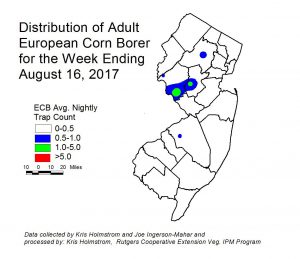 European corn borer (ECB) catches have been largely contained to Hunterdon and Somerset counties this past week (see ECB map at left). This flight has been very sporadic. ECB feeding in NJ sweet corn plantings is very low, and has been largely obscured by fall armyworm (FAW) feeding. Check 5 plants each in 10 random locations for a 50 plant sample. Look for “shot-hole” injury, and consider treating when the number of infested (from ECB or FAW) plants in a 50 plant sample exceeds 12%. As infested plants proceed to the pre-tassel stage, live larvae and damage may be found in the emerging tassels. Once plants hit full tassel, ECB larvae will move downward on the stalk and re-enter the plant near the area where ears are forming. This can result in direct injury to the ear. Growers should consider an insecticide application at the full tassel stage to target ECB larvae as they migrate downward. This application can eliminate larvae that have escaped any earlier insecticide applications.
European corn borer (ECB) catches have been largely contained to Hunterdon and Somerset counties this past week (see ECB map at left). This flight has been very sporadic. ECB feeding in NJ sweet corn plantings is very low, and has been largely obscured by fall armyworm (FAW) feeding. Check 5 plants each in 10 random locations for a 50 plant sample. Look for “shot-hole” injury, and consider treating when the number of infested (from ECB or FAW) plants in a 50 plant sample exceeds 12%. As infested plants proceed to the pre-tassel stage, live larvae and damage may be found in the emerging tassels. Once plants hit full tassel, ECB larvae will move downward on the stalk and re-enter the plant near the area where ears are forming. This can result in direct injury to the ear. Growers should consider an insecticide application at the full tassel stage to target ECB larvae as they migrate downward. This application can eliminate larvae that have escaped any earlier insecticide applications.
The highest nightly ECB catches for the previous week are as follows:
| Beckett 2 | Belvidere 1 | Medford 1 |
| Sergeantsville 2 | Denville 1 | Milford 1 |
| Allamuchy 1 | Eldora 1 | Phillipsburg 1 |
| Asbury 1 | Little York 1 | South Branch 1 |
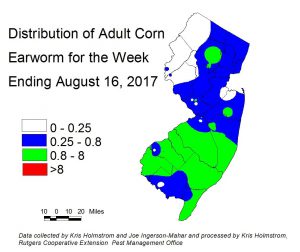 Corn earworm (CEW) moth populations continue to increase throughout the state, although there is less consistency to the catches in the northern counties (see CEW map at left). Catches in states to our south are not excessively high, so at this time indications are that CEW populations will continue to increase incrementally. In this map, areas in green roughly correspond to a 3-4 day schedule, while blue areas are 4-5 days. Be aware that synthetic pyrethroids have become less effective at managing ear infestations from this pest over the past several years. For this reason, it is advisable to include products in the IRAC group 28 (Coragen, Besiege) or IRAC group 5 (Radiant, Entrust (OMRI approved)).
Corn earworm (CEW) moth populations continue to increase throughout the state, although there is less consistency to the catches in the northern counties (see CEW map at left). Catches in states to our south are not excessively high, so at this time indications are that CEW populations will continue to increase incrementally. In this map, areas in green roughly correspond to a 3-4 day schedule, while blue areas are 4-5 days. Be aware that synthetic pyrethroids have become less effective at managing ear infestations from this pest over the past several years. For this reason, it is advisable to include products in the IRAC group 28 (Coragen, Besiege) or IRAC group 5 (Radiant, Entrust (OMRI approved)).
The highest nightly CEW blacklight trap catches are as follows:
| Downer 4 | Tabernacle 3 | Green Creek 2 |
| Denville 3 | Centerton 2 | Pedricktown 1 |
| Folsom 3 | Cinnaminson 2 | Princeton 2 |
| Medford 3 | Farmingdale 2 | Woodstown 2 |
Southern NJ CEW pheromone trap catches have remained fairly steady over the past week. This more conservative network is indicating an moderate threat level (see CEW pheromone map below at right). There are relatively few pheromone traps deployed compared to the number of blacklight traps in the state, resulting in much broader color bands on the pheromone map. Generally, the green portion of the map represents a 3-4 day schedule, while areas in red should adhere to a 3 day schedule.
At present, the highest nightly pheromone trap catches are as follows: 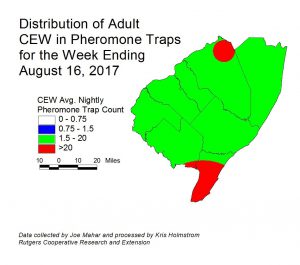
| Green Creek 48 | East Vineland 12 |
| Jobstown 22 | Pedricktown 11 |
| Pole Tavern 19 | Elm 7 |
| Beckett 13 | Woodstown 1 |
| Berlin 12 |
Fall Armyworm
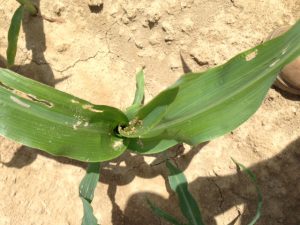 Fall armyworm (FAW) infestations in NJ are still occurring but have not increased significantly over the past several weeks. While new damage is being found on whorl stage plants, the occurrence has been lower than expected for this time of year. Larval populations are being managed effectively with appropriate insecticides when the infestations are identified promptly. We should be alert for increased infestation in the near future. This pest favors smaller whorl stage plants, and will even infest seedling stage plants if
Fall armyworm (FAW) infestations in NJ are still occurring but have not increased significantly over the past several weeks. While new damage is being found on whorl stage plants, the occurrence has been lower than expected for this time of year. Larval populations are being managed effectively with appropriate insecticides when the infestations are identified promptly. We should be alert for increased infestation in the near future. This pest favors smaller whorl stage plants, and will even infest seedling stage plants if the population is high. This pest is capable of serious injury to plants, and scouting should commence immediately on whorl corn throughout the southern half of the state. Look for plants with “window-pane” type feeding that leads from the outer leaf surface down into the whorl (see photo at left). As larvae grow, this damage will progress to obvious ragged holes, with lots of caterpillar droppings in the whorl. The larvae are tan and brown (see photo at right), with a conspicuous upside down “Y” on the head capsule. If FAW alone or in combination with ECB are found to infest 12% or more plants in the sample, consider an insecticide treatment. FAW do not respond well to synthetic pyrethroid insecticides. In general, IRAC Group 5 materials like Radiant or Entrust (OMRI approved) or IRAC Group 28 materials like Coragen (or those that contain Coragen as a component) work very well on FAW and other caterpillar pests.
the population is high. This pest is capable of serious injury to plants, and scouting should commence immediately on whorl corn throughout the southern half of the state. Look for plants with “window-pane” type feeding that leads from the outer leaf surface down into the whorl (see photo at left). As larvae grow, this damage will progress to obvious ragged holes, with lots of caterpillar droppings in the whorl. The larvae are tan and brown (see photo at right), with a conspicuous upside down “Y” on the head capsule. If FAW alone or in combination with ECB are found to infest 12% or more plants in the sample, consider an insecticide treatment. FAW do not respond well to synthetic pyrethroid insecticides. In general, IRAC Group 5 materials like Radiant or Entrust (OMRI approved) or IRAC Group 28 materials like Coragen (or those that contain Coragen as a component) work very well on FAW and other caterpillar pests.
Silking Spray Schedules*:
South – 3-4 days
Central – 3-4 days
North – 5-6 days
*These recommendations are based on regional catches. Adhere to tighter spray schedules if indicated by local trap catches.
Pepper Weevil Update
An infested field was discovered near Hammonton. Judging by the field’s location and where the infestation was in the field, most likely the invading weevils were transported into the field via equipment. An adult weevil was found on a pheromone trap in a nearby field. The biggest challenge will be to prevent the weevils from invading other nearby fields.
Brown Marmorated Stink Bug
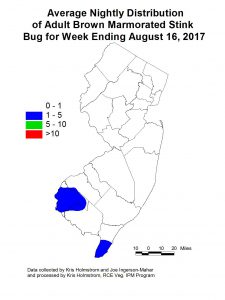 Black light trap catches of the brown marmorated stink bug (BMSB) are mostly occurring in the southwestern edge of NJ (see BMSB map at left). While no reports of major stinkbug injury have come in from field scouts, BMSB and other stinkbugs can become a problem should the weather turn dry. Scouting for stinkbugs in these crops requires stealth, as the bugs will retreat into the canopy if they perceive a threat. While scouting for other insects and diseases, approach each sample site slowly. Before disturbing the foliage to search for ECB eggs, aphids, etc., observe the upper canopy for the presence of stinkbugs. Often, they will bask on the upper leaves. If adults, nymphs or egg masses are found in 2 or more sites in a pepper planting, consider treating preventively to limit feeding injury to fruit. There are several insecticide options listed in the 2016-17 Commercial Vegetable Production Recommendations.
Black light trap catches of the brown marmorated stink bug (BMSB) are mostly occurring in the southwestern edge of NJ (see BMSB map at left). While no reports of major stinkbug injury have come in from field scouts, BMSB and other stinkbugs can become a problem should the weather turn dry. Scouting for stinkbugs in these crops requires stealth, as the bugs will retreat into the canopy if they perceive a threat. While scouting for other insects and diseases, approach each sample site slowly. Before disturbing the foliage to search for ECB eggs, aphids, etc., observe the upper canopy for the presence of stinkbugs. Often, they will bask on the upper leaves. If adults, nymphs or egg masses are found in 2 or more sites in a pepper planting, consider treating preventively to limit feeding injury to fruit. There are several insecticide options listed in the 2016-17 Commercial Vegetable Production Recommendations.
Pumpkins and Winter Squash
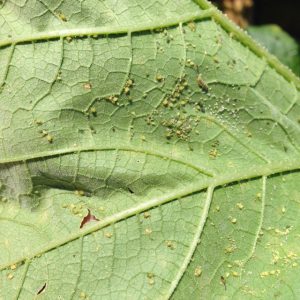 This is the time of year when melon aphid populations begin to appear in pumpkin and winter squash fields. These aphids can build to extremely high levels in fields (see photo at left), resulting in sticky droppings accumulating on the surface of maturing fruit.
This is the time of year when melon aphid populations begin to appear in pumpkin and winter squash fields. These aphids can build to extremely high levels in fields (see photo at left), resulting in sticky droppings accumulating on the surface of maturing fruit.
Cucurbit downy mildew (CDM) remains active on cucumber in NJ. As yet, no other cucurbit crops are infected in NJ but cantaloupe infections are now being reported in New York and pumpkin and butternut squash infections have now been discovered in Sussex County, Delaware. At this time, it is important for all cucurbit growers to check the below website at least weekly for updates on the movements of CDM in the eastern U.S. (http://cdm.ipmpipe.org/). While the imminent threat remains to cucumber, the CDM forecast issued by NC State had southern NJ at high risk to develop new infections from regional sources as of Tuesday 8/15. Existing infections will continue to develop. ALL cucurbit crops should be scouted for the presence of CDM, and all cucumber plantings should be treated preventively. CDM causes yellow lesions to develop on the upper leaf surface. Lesions are confined within veins initially, but coalesce quickly to kill the entire leaf when moist conditions prevail. Beneath these lesions (lower leaf surface), dark gray spores will be produced. If discovered, please report any incidence of CDM to your county agent as soon as possible.
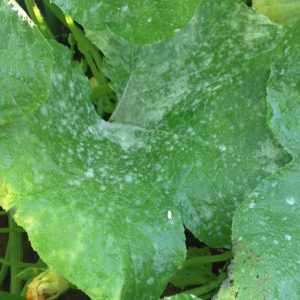 Powdery mildew (PM) infections are light to moderate on most pumpkin and winter squash fields. The appearance of PM is not related to weather, but rather the maturity and stress level of plants. This disease is not nearly as destructive as DM, but must be managed sufficiently to permit continued vine health. PM lesions first appear as circular clusters of conidia (spores) on the upper or lower surface of older leaves (see photo at left). PM typically appears as the earliest fruit are developing. The threshold for beginning the PM protectant fungicide program is the appearance of 2 leaves with lesions out of a sample of 100 older leaves. For a comprehensive list of useful fungicides and their use in rotation, see the Pumpkin and Winter Squash section of the 2016-17 Commercial Vegetable Recommendations Guide.
Powdery mildew (PM) infections are light to moderate on most pumpkin and winter squash fields. The appearance of PM is not related to weather, but rather the maturity and stress level of plants. This disease is not nearly as destructive as DM, but must be managed sufficiently to permit continued vine health. PM lesions first appear as circular clusters of conidia (spores) on the upper or lower surface of older leaves (see photo at left). PM typically appears as the earliest fruit are developing. The threshold for beginning the PM protectant fungicide program is the appearance of 2 leaves with lesions out of a sample of 100 older leaves. For a comprehensive list of useful fungicides and their use in rotation, see the Pumpkin and Winter Squash section of the 2016-17 Commercial Vegetable Recommendations Guide.
Tomatoes
As per Dr. Wyenandt’s Disease Update of 8/10/17, late blight has been discovered in southeastern PA. This particular outbreak has the potential to infect both tomato and potato. For more details, refer to Dr. Wynandt’s post: https://plant-pest-advisory.rutgers.edu/vegetable-disease-update-81017/

